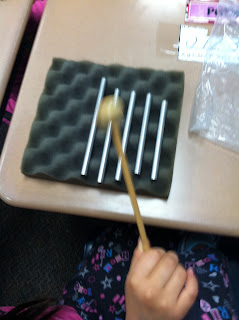Math- Last week, we worked on fractions that equal one half. We also used pattern blocks to mix and match 1/3, 1/6, and 1/2 combinations to make a whole. Students used these and turned them into equations. Today, we used fraction magnets to start our work on equivalent fractions.
Reading-
This week we will read The Streets are Free by
Kurusa. This story is based on a true story about hoe neighbors in a poor
district in Caracas, Venezuela join together to build a much-needed playground.
The children’s inspiration and the adult’s cooperation are equally important in
coming up with a solution to the problem.
Writing- Last week, we finished our note taking on our animals. We then turned this into a T-chart. This week we will work on number notes, and the rough draft of our rainforest animal report.
Science- This week we started our Physics of Sound science unit. Here is a quick break down. On Monday- We took our Social Studies assessment.
On Tuesday- We explored sound discrimination and the properties of sound with drop chambers. After getting accustomed to the sounds, students created codes for their partner to spell out words depending on what object was being dropped in the chamber.
.JPG) |
| Drop Chamber |
.JPG) |
| Drop Chamber with objects |
.JPG) |
| Drop Chamber in action |
.JPG) |
| Codes |
.JPG) |
| Codes assigned to objects |
On Wednesday- We started our discussions on tone and vibrations. We took a look at a bean on a tone generator and how a high pitch vibrates faster than a low pitch. We continued to explore using long gongs (a cup on a string tied to a metal clothes hanger) and tuning forks.
 |
| Tuning fork and ping pong ball |
 |
| Long Gong |
 |
| Tuning fork on paper |
 |
| Tuning fork with water |
 |
| Long Gong |
On Thursday and this morning- We looked at pitch and how pitch is determined by the amount of water in a waterphone or the length of the tube on an xylophone. The smaller the amount of water or shorter the tube, the higher the pitch. The more water or the longer the tube, the lower the pitch.
 |
| Arranging xylophone tubes |
 |
| Creating a song |
 |
| Arranging waterphones |
Just a reminder, Thursday, February 21 is the 3rd grade informance. Our class will perform at 7:30 pm. The informance will last approximately 45 minutes.
Have a great week!
Mrs. Jodie Yuska
-->
2012-2013 Third Grade Reading
Rubric for Report Card
|
Resource
for grading
|
Trimester
2
|
Vocabulary: Understands
3rd Grade Vocabulary
|
Basal
Story Assessment & Text talk
|
90%
and above 4
80%-89%
3
70%-79%
2
69%
or below 1
|
Comprehension: Independently
Comprehends 3rd Grade Reading Material
|
Basal
Story Assessment
|
90%
and above 4
80%-89%
3
70%-79%
2
69%
or below 1
|
Fluency: Independently
Reads a 3rd Grade Passage
|
Guided
Reading Level and Dibels Passage
|
N
or above 4
M
3
L
2
K
or below 1
Also
use the Fluency 5 Point Scale with Guided Reading lessons to assess
fluency.
|
2012-2013 Third Grade Writing
Rubric for Report Card
|
Resource
for grading
|
Trimester 2
|
|
Develops
and organizes effectively in written form
|
Write
Tools
Writing
Samples
|
* Writes a
paragraph with a topic sentence, concluding sentence, a big idea, and a give
me more (2 greens, one yellow and one pink)
all 4 = 4
3 out of the 4 = 3
2 out of the 4 = 2
1 out of the 4 = 1
|
|
Word
Usage
|
Write
Tools
Writing
Samples
|
· Uses
correct grammar
|
|
Applies
correct capitalization and punctuation in written work
|
Write
Tools
Writing
Samples
|
· Capitalizes
days of the week, months of the year
· Capitalizes
salutations and closings of letter
· Capitalize
beginning of nouns
|
|
Spells
correctly in written work
|
Write
Tools
Writing
Samples
|
· Spells
frequently used words (tricky words) correctly
|
|
2012-2013
Third Grade Spelling Rubric for Report Card
|
Resource
for grading
|
Trimester 2
|
|
Spelling
|
Words
Their Way
|
List D:
4- above 90%
3- above 75%
2- above 65%
1-below 65%
List C:
3- above 90%
2- above 65%
1- below 65%
|
|
Handwriting
|
Loops
and Groups
Daily
Work
|
Students will be assessed on their cursive
handwriting as well as their handwriting on daily assignments.
|
|
2011-2012
3rd
grade Math rubric
|
Resources
|
Trimester
2
|
|
Number
and Operation:
|
|||
Demonstrates understanding of place value
|
Investigations and McGraw Hill textbooks
|
· Compare
and order numbers through 100’s
· Ordinal
numbers and estimation
· Rounding
to 10’s and 100’s
· Skip
count by 2, 3, 5, and 10 (starting at various numbers)
|
|
Demonstrates an understanding of fractions
|
Investigations and McGraw Hill textbooks
|
· Read,
write, and compare fractions >, <, and = to 1
· Knows
½, ¼, and 1/3
|
|
Uses problem solving strategies
|
Investigations, ADD Math, McGraw Hill textbooks
|
· Can
solve multiplication, subtraction, and addition story problems
|
|
Uses multiplication skills
|
Time tests
|
· %
0n Assessment
o
90% + = 4
o
80-89% = 3
o
70-79% = 2
o
78% or less = 1
|
|
Algebra
|
|||
Solving for an unknown
|
Investigations and McGraw Hill textbooks
|
· Solve
patterns for 2, 3, 5, and 10
· Solve
for an unknown in addition and subtraction
(5+?= 8,
10-?= 2)
· Quantitative
change with one variable leads to a change in the second variable (Stacy is
10, her mom is 38. When Stacy is 12, will her mom be older, younger, or stay
the same?
|
|








